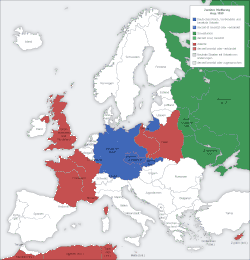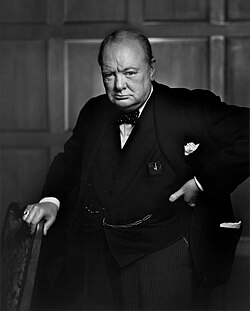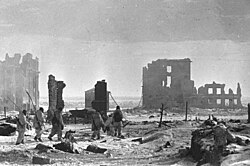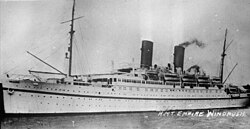
The Second World War was the defining military conflict of modern history, fought between the Axis powers led by Nazi Germany and the Empire of Japan and the Allies led by the United States, the Soviet Union and Britain. It was initiated in September 1939 by the Nazis in their desire to create a new German Third Reich which would rule over Europe. Over six years of conflict down to the autumn of 1945, between sixty and eighty million people lost their lives either through direct combat, civilian casualties, or the genocidal programs of the Nazis in Europe. In its aftermath, the world order was reshaped, with the United States and the Soviet Union emerging as the two dominant global superpowers that would fight a bitter Cold War for the next four and a half decades. The war resulted in enormous changes in demography around the world, particularly in Europe. Many countries had seen a drastic reduction in the number of young men within their borders owing to war casualties. As a result, the 1940s and the 1950s saw countries like Britain and Germany actively promoting migration into their countries from regions like the Caribbean and Turkey. In the process, they radically changed the demography of their nations in modern times.[1]
Chronology of eventsChronology of events
The roots of the Second World War lay in the rise of the Nazi Party under Adolf Hitler in Germany in the early 1930s. Their ascendancy was possible owing to the economic crisis which followed the Wall Street Crash of 1929 and the ensuing Great Depression, as well as German general resentments at the peace terms which were imposed on the country following the World War I. The Nazis were bent on creating a German-dominated, racialized European empire and so began rearming in preparation for a war in 1935. By 1938, they felt powerful enough to annex Austria and make further territorial demands on Czechoslovakia. Owing to the slow speed with which Britain and France began preparing their own armed forces, it was not until Germany invaded Poland in September 1939 that the Western powers finally declared war on Germany.[2]

The conflict would last for six years and was the bloodiest war of modern history. It can broadly be divided into two parts: The first of these, lasted from the start of the war in 1939 down to the end of 1941: during this period, Germany met with enormous success on the battlefield, conquering Poland in the autumn of 1939 before occupying neutral Denmark and Norway the following spring. A blistering military campaign westwards in the early summer of 1940 brought the Low Countries and France under Nazi control.[3] Only Britain, led by Winston Churchill remained opposed to the Germans in Western Europe by that time. Meanwhile, Germany’s allies, Italy and Japan, began conquering extensive territories in the Balkans and parts of China and the Western Pacific. When the Germans invaded the Soviet Union in the summer of 1941, the campaign progressed rapidly at first, and by the late autumn Nazi divisions were near the outskirts of Moscow and Leningrad. It seemed at that juncture that the Axis powers, as they were termed, would emerge to dominate much of the world.[4]

The tide turned dramatically in the winter of 1941, when the German advance stalled in the Russian winter and the Soviet Union began to fight back. Then the Empire of Japan attacked the United States in December 1941 without a declaration of war; this brought the world’s emerging superpower into the conflict. Facing an alliance of the USA, Britain and the Soviet Union, the Axis powers began to suffer reversals in 1942. The crucible of the war was the Eastern Front and in particular, the Battle of Stalingrad, which began in the autumn of 1942. When the Germans lost their first major campaign here in the spring of 1943, it set the tone for the remaining years of the conflict.[5] In the summer of 1943, after victory over the Italians and Germans in North Africa, the Western Allies invaded southern Italy, leading the Italian government to overthrow its leader and Hitler's ally, Benito Mussolini. The USA, the UK, Canada and others followed this by opening a western front in northern France in the summer of 1944. Yet the key conflicts remained in Eastern Europe and it was the Russians who would ultimately end the war by seizing Berlin in the spring of 1945. The Japanese only surrendered after the United States dropped two nuclear weapons on the cities of Hiroshima and Nagasaki in early August 1945.[6]
The war was the most brutal in modern history; it is estimated that between sixty and eighty million people lost their lives. Six million alone were European Jews who were systematically murdered by the Nazis during the Holocaust, the most vicious genocide in human history. The Soviet Union suffered more than any other nation, with nine Soviet soldiers having lost their lives for every German soldier killed. Civilian deaths were in the tens of millions and extended well beyond Europe. For instance, three million people died in the Bengal Famine in what is now north-eastern India and Bangladesh. The war also left many countries massively depopulated and this led to significant migration in the years and indeed decades after the war.[7]
Extent of migrationExtent of migration

The demographic impact of the war was enormous, virtually ending the millennia-long presence of the Jewish people across the continent, as millions had died and many more left Europe for the US or Israel following the conflict. This was especially notable in Eastern Europe and in Poland and Ukraine in particular, which regions had been home to millions of Ashkenazi Jews since medieval times.[8] The changes were also great in countries like Britain, Germany, and the Soviet Union, which had sustained the most losses of young and middle-aged men of fighting age. For instance, by the end of the war, the Nazis had been drafting teenagers and older men to fight, due to the dire lack of manpower; young men of working age were consequently needed to rebuild Germany after the war. To provide for this, the government of West Germany issued passes for what were known as Gastarbeiter or 'guest workers' to come and live and work in Germany. A great proportion of these guest workers came from Turkey, though guest worker agreements were also reached between West Germany and countries like Tunisia, Spain, Yugoslavia, Portugal and even South Korea.[9] A similar scenario prevailed in Britain. The government there elected to begin alleviating the post-war labor shortage by inviting people from its colonies in the West Indies to come and work in Britain; the first of these newcomers arrived in Britain onboard the HMT Empire Windrush in the summer of 1948 and the subsequent waves of migration which followed have led to the migrants becoming known as the Windrush Generation.[10]
Demographic impact of the Second World WarDemographic impact of the Second World War
The demographic impact of all of this post-war migration has been enormous; for example, up to the early 1970s nearly one million Turks arrived in West Germany on 'guest worker' permits. Many returned home after working there for several years, but hundreds of thousands remained. Today, the Turkish-German community is estimated to be two and a half to three million people, with Turkish-Germans such as the film director, Fatih Akin, and the footballer, Mesut Özil, being prominent in German society.[11] The changes which occurred in British society as a result of the arrival of the Windrush Generation were even greater: by the early 1960s, nearly a quarter of a million had arrived in Britain from the West Indies and this continued until 1973, when legislation was introduced to curb migration in the face of rising unemployment. This laid the basis for the emergence of the Black African-Caribbean community within Britain, one of the country’s more significant minorities. It also began the process whereby Britain became a multicultural society in the course of the second half of the twentieth century as people from across Britain’s former empire made Britain their home.[12] Similar patterns of migration in the post-war period from former colonies took place in countries like France and the Netherlands to make up for labor shortages in the post-war years.
See alsoSee also
Research military records on MyHeritageResearch military records on MyHeritage
Notable World War II record collections on MyHeritageNotable World War II record collections on MyHeritage
| Name of collection | Number of records | ||
| U.S. World War II Army Enlistment | 5,998,078 | ||
| Soviet Prisoners of World War II Held in Germany | 1,255,187 | ||
| Ukraine, World War II Casualties | 1,639,902 | ||
| France, World War II Prisoners of War | 723,075 | ||
| World War II Reserve Corps Records | 333,442 | ||
| New Zealand, Army Expeditionary Force Nominal Rolls | 181,281 | ||
| Kansas, World War II Selective Service Records | 223,811 | ||
| Georgia, World War II Draft Registration Cards, 1940-1942 | 130,414 | ||
| US World War II Prisoners of War, 1941 - 1946 | 107,979 | ||
| Finland, Second World War Casualties | 94,510 |
See alsoSee also
Explore more about World War IIExplore more about World War II
- Military Records: Search by Name on MyHeritage on the MyHeritage Knowledge Base
- World War II record collections on MyHeritage
- Researching Your World War II Ancestors: Part 1 – The Road to War at Legacy Family Tree Webinars
- Researching Your World War II Ancestors: Part 2 – Records of the Army at Legacy Family Tree Webinars
- Researching Your World War II Ancestors: Part 3 – Records of the Navy, Marines, and Coast Guard at Legacy Family Tree Webinars
- Researching Your World War II Ancestors: Part 4 – War on the Home Front & Post-War Years at Legacy Family Tree Webinars
- He Found 357 Letters His Uncle Wrote Before Falling in Battle During WWII on the MyHeritage blog
- 75 Years After 2-Year-Old and Mother Separated at Auschwitz, Their Families Find Each Other on the MyHeritage blog
- I Reunited with My Father’s Lost Family Thanks to a Smart Match™ on MyHeritage on the MyHeritage blog
- Her Parents Left Her on a Bench to Save Her from the Nazis. At 80, She Reunited with a Long-Lost Cousin on the MyHeritage blog
References
- ↑ World War II Major Events Timeline. PBS
- ↑ GERMAN PREWAR EXPANSION. United States Holocaust Memorial Museum
- ↑ The Fall of France. BBC
- ↑ Operation Barbarossa. History Channel
- ↑ Battle of Stalingrad - WW2 Timeline (August 1942 - February 2nd, 1943). Second World War History
- ↑ D-DAY. U.S. Army
- ↑ World War II. History Channel
- ↑ HOLOCAUST SURVIVORS AND THE ESTABLISHMENT OF THE STATE OF ISRAEL (MAY 14, 1948). United States Holocaust Memorial Museum
- ↑ Thomas, W. S. G. "GASTARBEITER" IN WESTERN GERMANY. Geography, Vol. 59, No. 4 (November 1974), pp. 348-350
- ↑ What is Windrush and who are the Windrush generation?. BBC News
- ↑ Turkish guest workers transformed German society. Deutsche Welle
- ↑ Black British. Minority Rights Group

